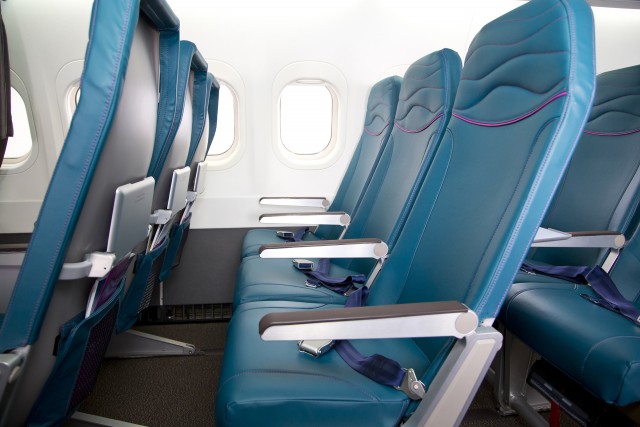
Hawaiian Airlines is streamlining their 717 cabins – Photo: Hawaiian Airlines
Hawaiian Airlines is now the second-largest operator of Boeing 717s in the world — with a fleet of 18 (tied with QantasLink — Delta is number one). Even though it is a smaller fleet, the airline operates five different configurations of the aircraft type, which they use to fly inter-island.
To simplify, the airline has decided to standardize each aircraft with 128 new seats and also update some of the design elements of the cabin.
“These new, modern design elements rejuvenate the interiors of our Boeing 717s while allowing us to deliver a consistent onboard experience for our guests,’ said Peter Ingram, chief commercial officer for Hawaiian Airlines.
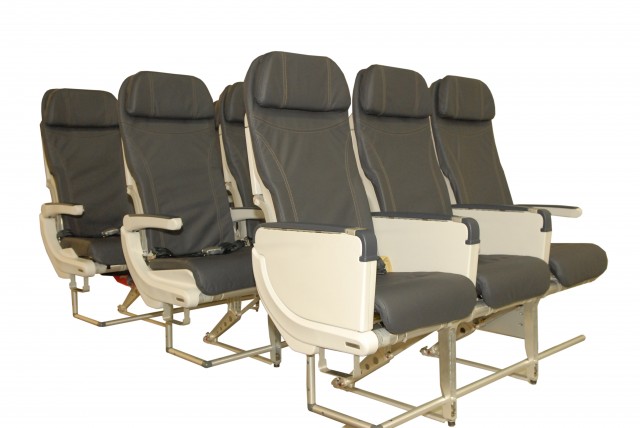
Alaska Airlines new New Recaro seats for economy class that will make their appearance on the airline's new Boeing 737-900ERs. Image from Alaska.
Alaska Airlines has announced that they will be installing new seats from Recaro Aircraft Seating on their 22, soon-to-be delivered, Boeing 737-900ERs.
The seats will offer a six-way adjustable headrest, three inches of recline and an additional inch of legroom.
The additional leg room will not affect the airline’s seat pitch of 31-32″, but it will offer more room for your legs. “The extra inch we refer to is gained by Recaro’s clever design that effectively adds one more inch of room to your living space, without us moving the seats further apart,” Alaska spokes person confirmed to AirlineReporter.com. “Specific to pitch, our pitch will stay consistent with our current standard 31-32 inches.”
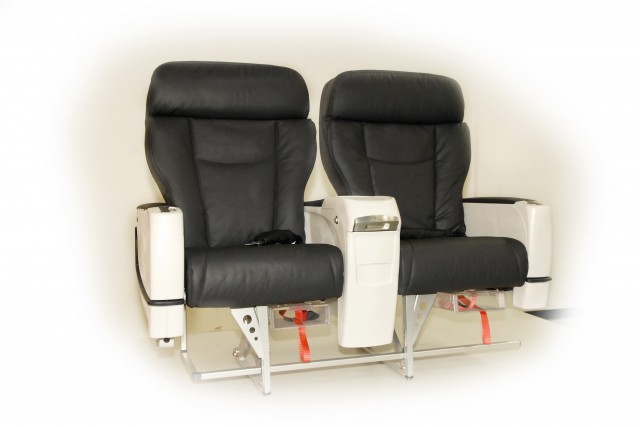
Alaska Airlines new New Recaro seats for First Class that will make their appearance on the airline's new Boeing 737-900ERs. Image from Alaska.
Alaska will also get new Recaro seats for the first class cabin that will offer five inches of recline, an articulating seat bottom and a six-way adjustable headrest.
The seat, “design includes a comfortable yet slimmer seatback and bottom and a literature pocket located above the tray table,” said Joe Sprague, Alaska Airlines’ vice president of marketing. “The new seats add to a very special onboard experience that all of our customers flying Alaska’s new 737-900ERs will enjoy, including Boeing’s Sky Interiorwith its improved lighting and sculpted overhead bins that create a more spacious cabinonboard Wi-Fi, Starbucks coffee, premium Washington wines and delicious meals for purchase, as well as our renowned personal service.”
The seats are also lighter and are expected to save about 8,000 gallons of fuel annually per aircraft.
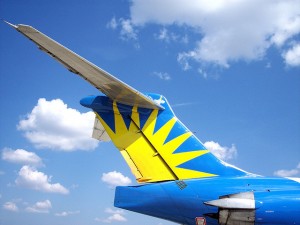
Allegiant MD-80 tail with a clear blue sky
Allegiant Air announced today that they will be adding 16 additional seats to most of their MD-80 aircraft. All of the 48 currently operating and nine of the additional ones will be operating with 150 seats will be changed to accommodate 166 seats. The three MD-87’s that hold 133 seats will not be changed.
Allegiant is investing $50million into this change, which includes removing the galleys. They will start the changes near the end of 2011 and will be completed by the end of 2012.
“These added seats will allow us to grow our capacity with the least amount of risk,” Andrew C. Levy, Allegiant President, said. “This project effectively increases our capacity by 11 percent while lowering our cost per seat. In addition, we expect to fund this through internally generated cash-flow.”
This investment shows that Allegiant will continue with their fleet of MD-80 aircraft as well as their newer Boeing 757s for the future.
Due to the increase in passengers, Allegiant will be adding a fourth flight attendant to the 166 passenger aircraft. This increases the ratio of flight attendant to passenger from 1:50 to 1:42.
I wondered if this would mean Allegiant would offer less seat pitch for customers. Just back in 2004, Allegiant made a big deal about taking out three rows of seats to provide more leg room (thanks to Dan Webb for that link). I asked Jordan McGee, Director if Allegiant Corporate Communications and she explained that all Allegiant’s aircraft are not configured the same, but even after the conversion to 166 seats, all the aircraft will have a seat pitch between 30-32 inches.
“Our current seat pitch varies by aircraft because of different configurations, but our average is 30-32 inches. We also have quite a few seats at 33 inches and then some upwards of that, depending on the aircraft. Once we make the conversion to 166 seats, each seat will be between 30-32 inches,” McGee explained.
If they aren’t using the galleys to serve food, why have them? Heck, if Allegiant can put in more seats and more flight attendants while not taking any leg room away from me and while trying to keep fares competitive, I am all for it.
Image: p1anespotting
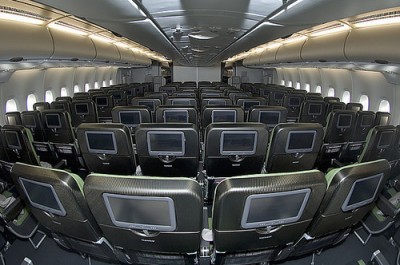
Slim and light don't describe the Airbus A380, but sure do describe Qantas' carbon fiber seats on their A380.
The Airbus A380 is the largest commercial airline in the sky today. It is massive. When you think about this plane you don’t think about “light.” However there is something light about the seats on Qantas Airbus A380’s…they have carbon fiber.
What’s carbon fiber you ask? (if you don’t ask, skip this paragraph) In easy terms it is woven fiber material that is stronger and lighter than metals used in other airline seats. For a more complex answer, read this. While the carbon fiber on the seats is what got my attention about the Qantas’ seats, there are plenty of other cool things going on.
About a year ago, Mary Kirby, via her Runway Girl Blog, talked about the 2009 Australian International Design Award of the Year for their seats. Not only because of the high-tech materials used, but also the way the seats recline. Like a high-end movie theater, the bottom part of the seat moves forward when one reclines, taking away less room from the person behind you.
Qantas told me, ’œThe carbon fibre backshell on the Qantas A380 Economy seats is exclusive to Qantas and provides a unique natural element and visually stunning appearance. The material was selected for sleek design appeal and aircraft weight benefits.’
These carbon seats might be exclusive now, but I am sure we will be seeing seats like these on future flights. As carbon fiber gets cheaper and airlines are looking to cut costs and green house emissions I imagine more carbon fiber will be used. And as Kirby shows, you might be seeing this seat on a Boeing 787 Dreamliner as well.
Two more pictures: ONE & TWO
Thanks Dan for pointing this out!
Image: Jalopnik
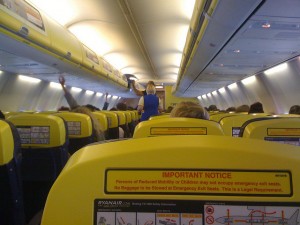
I doubt these yellow Ryanair seats will be taken out for stand up seats anytime soon
I debated if I should even blog about this, but figured why not?
Ryanair is out there running its (genius) PR machine again. It doesn’t matter how many times Ryanair says something the media will pick it up and treat it like fact. I love Ryanair’s ability to consistently do this and especially with a topic that has already been picked up previously. They will talk about some radical money-saving scheme (ie paid toilets) and then it never happens. Yet passengers get the idea that Ryanair is willing to do almost anything to save passengers money and look to them for the cheapest ticket possible, while Ryanair gets tons of free publicity. Like their PR strategy or hate it, at least it works (and I know I am guilty of helping them out).
Anyhow, Ryanair is at it again saying they are looking to provide uber low fares on stand up seats, but Boeing is saying no way. Aubrey Cohen with the Seattle PI quotes Boeing as saying, “We are not considering standing-only accommodations, nor do we have any plans to do so. Among other things, stringent regulatory requirements — including seats capable of withstanding a force of 16 Gs — pretty much preclude such an arrangement.”
Even though I don’t think it is that crazy of an idea to offer stand-seating in the future, I doubt we will be seeing them anytime soon. Many short-hop flights from 30-90 minutes could be done standing up. Think of riding a full bus or train and seeing people having to stand for longer periods of time. Unlike a bus or train, an airplane under-goes much more force with take off and landing.
Even if standing seats did exist, would they make economical sense? Ryanair is saying they would charge as little as $6 for a standing seat. Adding extra seats, but reducing fares while having to haul around more weight doesn’t seem to make business sense. It would most likely be more cost effective just to keep the sitting seats and charge more.
Image: GetDown





